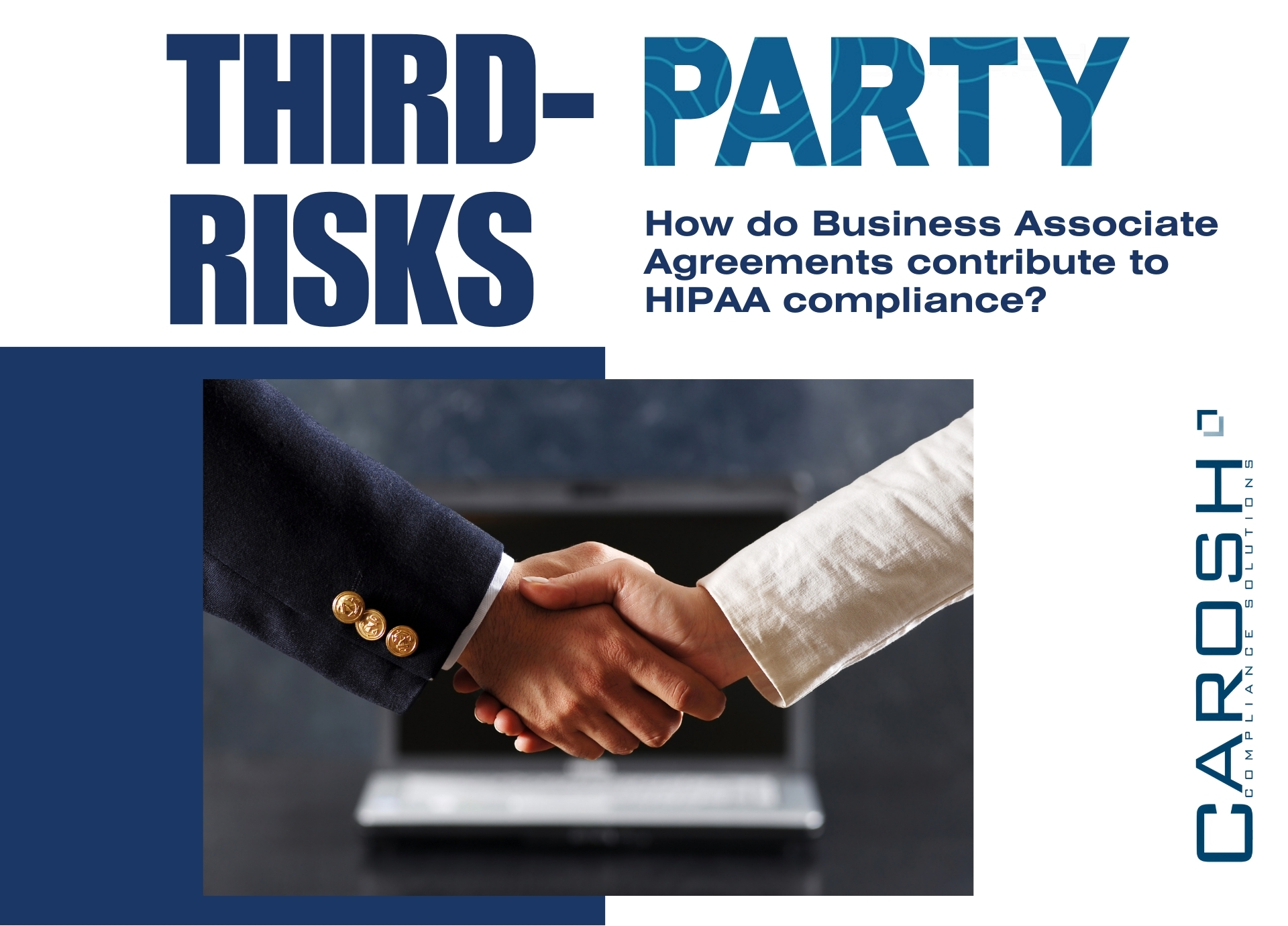
In the intricate landscape of healthcare data protection, managing third-party risks under the Health Insurance Portability and Accountability Act (HIPAA) is a paramount concern for healthcare entities. Third parties, or business associates, play a crucial role in the healthcare ecosystem, often handling, transmitting, or storing Protected Health Information (PHI) on behalf of covered entities. This comprehensive guide delves into the multifaceted approach required to effectively manage these third-party risks. It covers the identification and assessment of business associates, the critical role of Business Associate Agreements (BAAs), continuous monitoring and management strategies, training and awareness initiatives, incident response planning, and the importance of a comprehensive vendor risk management program. Understanding and implementing these strategies are essential for maintaining HIPAA compliance and protecting patient information in today’s interconnected healthcare environment.
Identification and Assessment of Third Parties
Identifying business associates in the context of HIPAA compliance is a crucial first step in managing third-party risks. This process involves a careful examination of which external service providers have access to Protected Health Information (PHI) and are, therefore, subject to the regulations set forth by HIPAA. Typically, business associates include a range of entities such as billing companies, which handle patient billing information; IT vendors, who may manage or support healthcare information systems; consultants who have access to PHI for analysis or advisory purposes; and data storage firms that store or process patient data. This identification process is critical because any entity that handles PHI on behalf of a covered entity must comply with HIPAA’s stringent privacy and security rules.

Conducting Thorough Risk Assessments
Once business associates are identified, the next essential step is to conduct thorough risk assessments for each of them. These risk assessments are integral to understanding and mitigating the potential risks and vulnerabilities associated with the handling of PHI. During this assessment process, covered entities must evaluate how these third parties manage and protect data. Key aspects to consider include the third party’s data management practices, their security protocols, and their track record of compliance with relevant regulations. This evaluation should delve into the specific ways in which the business associate interacts with PHI, including how they access, transmit, store, and dispose of it.
Evaluating Security Practices
The risk assessment should also scrutinize the business associate’s security practices. This involves assessing their use of encryption, firewall protection, intrusion detection systems, and other security measures designed to protect data integrity and confidentiality. The assessment can also include a review of the business associate’s policies and procedures related to data security, employee training programs, incident response plans, and their history of handling PHI. Additionally, it’s important to evaluate the business associate’s compliance history. This includes checking for any past security breaches, incidents of non-compliance, and understanding how these incidents were addressed.
Compliance History Review
Furthermore, risk assessments are not a one-time activity but should be an ongoing process. Regular reviews and updates are necessary to ensure that the business associate continues to adhere to HIPAA requirements and to account for any changes in their operations or services that might affect the security and privacy of PHI.
Ongoing Third-Party Risks Management
Effectively managing third-party risks in HIPAA compliance starts with the careful identification of business associates, followed by conducting comprehensive risk assessments. These assessments are crucial for evaluating how these third parties manage PHI, their adherence to security practices, and their history of compliance. This proactive approach is vital to safeguarding patient health information and maintaining the integrity of healthcare data management in the complex ecosystem of healthcare providers, business associates, and patients.
Third Party and Business Associate Agreements (BAAs)
Establishing Business Associate Agreements (BAAs) is a fundamental and critical step in effectively managing third-party risks under HIPAA. These agreements are legally binding contracts that are pivotal in defining the relationship between a covered entity and its business associates, specifically concerning the handling and protection of Protected Health Information (PHI). The primary purpose of a BAA is to ensure that business associates who have access to PHI understand and agree to comply with the necessary HIPAA requirements to protect patient privacy and data security.

Specifics and Permissible Uses of PHI
The specifics of a BAA are comprehensive and must be meticulously outlined to cover all aspects of PHI handling. Firstly, the agreement should clearly specify the permissible uses and disclosures of PHI by the business associate. This specification ensures that the business associate uses the PHI only for the purposes outlined by the covered entity and as permitted under HIPAA. The BAA should also explicitly state that any other use or disclosure not explicitly authorized by the covered entity or required by law is prohibited.
Implementation of Safeguards
Another critical component of BAAs is the stipulation regarding the implementation of safeguards. Business associates are required to put in place appropriate administrative, physical, and technical safeguards to prevent unauthorized use or disclosure of PHI. These safeguards might include data encryption, secure data transmission methods, access control measures, and employee training programs. The aim is to ensure the confidentiality, integrity, and availability of the PHI, thereby reducing the risk of data breaches or unauthorized access.
Breach Reporting Protocols
Moreover, BAAs should include specific terms for reporting any breaches of PHI. This includes stipulating the timeframe within which the business associate must report a breach to the covered entity and the type of information that must be included in the breach notification. The breach notification clauses are critical as they enable the covered entity to take timely action in response to any potential or actual breaches, thereby mitigating the impact and complying with the HIPAA Breach Notification Rule.
In essence, BAAs are not just formalities but essential tools in the HIPAA compliance process. They establish clear expectations and responsibilities for both the covered entity and the business associate regarding the protection of PHI. By meticulously detailing the permissible uses and disclosures of PHI, requiring robust safeguards, and setting forth breach reporting protocols, BAAs play a crucial role in ensuring that third-party business associates adhere to the same high standards of privacy and security as the covered entities themselves. This, in turn, helps in maintaining the overall integrity and confidentiality of patient health data in the broader healthcare system.
Ongoing Monitoring and Management of Third Parties
Continuous monitoring is an essential aspect of managing third-party risks under HIPAA, especially in ensuring that business associates maintain compliance with the established standards. Regularly monitoring the compliance status of business associates is crucial as it helps in detecting any deviations or lapses in adherence to HIPAA regulations and the agreed-upon security measures outlined in the Business Associate Agreements (BAAs). This ongoing oversight typically involves conducting periodic reviews, audits, or assessments of the business associates’ practices and procedures related to the handling of Protected Health Information (PHI).
Methodologies for Continuous Monitoring
The process of continuous monitoring may encompass various methodologies. For instance, periodic reviews might include scheduled check-ins or surveys with the business associates to assess their current compliance status. Audits are more in-depth and might involve an examination of the business associates’ security policies, data protection measures, employee training programs, and incident response plans. These audits can be conducted internally by the covered entity or externally by independent auditors. Additionally, assessments could involve on-site visits to physically verify the implementation of security measures and procedures.
Performance Evaluation of Business Associates
Another key component is the performance evaluation of business associates. This involves a continuous analysis of various metrics and documentation that provide insights into how effectively the third parties are adhering to HIPAA requirements. Performance evaluation can include scrutinizing audit reports, which offer detailed findings on compliance with specific HIPAA standards. Security incident reports are also crucial as they provide information on any potential or actual breaches of PHI, including how the incidents were managed and resolved. Other relevant compliance documentation, such as training records or evidence of risk assessments, can further assist in evaluating the business associate’s commitment to HIPAA compliance.
Dynamic Nature of Monitoring and Evaluation of Third-Party Risks
Continuous monitoring and performance evaluation are not static processes; they need to be dynamic to adapt to changes in regulations, emerging threats, and evolving practices in data management and security. By regularly evaluating and monitoring their business associates, covered entities can ensure that any risks related to the handling of PHI are promptly identified and addressed. This proactive approach is vital not only for maintaining compliance with HIPAA regulations but also for preserving the trust and confidentiality inherent in the healthcare provider-patient relationship. Through diligent and ongoing oversight, covered entities can uphold the high standards of privacy and security essential in the healthcare sector.
Training and Awareness
Educating third parties, particularly business associates, about HIPAA requirements is a critical component of managing third-party risks in healthcare. Ensuring that these associates are well-informed and up-to-date with HIPAA regulations is essential for maintaining the integrity and confidentiality of Protected Health Information (PHI). Many covered entities take proactive steps to educate their business associates by providing or requiring them to participate in specific training programs. These training programs are designed to cover various aspects of HIPAA, including privacy and security rules, the proper handling of PHI, and the protocols to follow in case of a data breach.
Comprehensive Training Programs
The content of these training programs is often comprehensive, addressing the fundamental principles of HIPAA, the responsibilities of business associates under the law, and practical guidance on implementing effective privacy and security measures. The goal is to ensure that business associates not only understand the legal implications of HIPAA compliance but also recognize their critical role in protecting patient information. In some cases, these training programs are tailored to the specific services provided by the business associate, focusing on the areas of highest risk or exposure to PHI.
Raising Awareness and Regular Communication
In addition to formal training programs, raising awareness among third parties about changes in HIPAA regulations, emerging risks, and best practices for securing PHI is vital. Regular communication plays a significant role in this process. Covered entities often use newsletters, webinars, workshops, or regular meetings to update their business associates on the latest developments in HIPAA regulations and compliance requirements. These communications may also include information about new threats to data security, such as emerging cyber threats or new tactics used by data thieves, and advice on how to mitigate these risks.
Sharing Best Practices for Securing PHI
Moreover, sharing best practices for securing PHI is an integral part of this educational effort. This can involve providing guidance on advanced data encryption methods, recommending security software, or advising on policies and procedures that enhance data security. By continually engaging with their business associates and providing them with the necessary resources and information, covered entities can foster a culture of compliance and vigilance. This not only aids in the protection of PHI but also strengthens the overall healthcare ecosystem’s resilience against data breaches and other security incidents.
Educating third parties and raising awareness about HIPAA compliance is a dynamic and ongoing process. It involves equipping business associates with the knowledge and tools necessary to comply with HIPAA regulations and keeping them informed about the evolving landscape of data protection. These efforts are crucial for ensuring that every entity involved in handling patient health information remains committed to maintaining the highest standards of privacy and security.
Incident Response and Reporting
Implementing breach notification protocols is a crucial aspect of managing third-party risks under the Health Insurance Portability and Accountability Act (HIPAA). It is essential that business associates fully understand their obligations to report any breaches of Protected Health Information (PHI) in a prompt manner, as stipulated in the Business Associate Agreements (BAAs) and under HIPAA guidelines. These protocols are not merely procedural; they are critical to the swift and effective handling of data breaches, ensuring that all necessary steps are taken to mitigate the impact and prevent further unauthorized access or disclosure of PHI.

Breach Notification Protocols
The breach notification protocols should clearly outline the process and timeframe within which business associates must report any incidents of PHI breach to the covered entity. This includes specifying the nature of information required in the breach notification, such as the details of the PHI involved, the circumstances of the breach, the number of individuals affected, and the steps taken by the business associate to address the breach. The objective is to ensure that the covered entity is immediately informed about any potential or actual breach, enabling them to take appropriate remedial actions, including notifying affected individuals, the Department of Health and Human Services (HHS), and, in certain cases, the media.
Coordinated Incident Response Plan
Alongside breach notification protocols, having a well-coordinated incident response plan that includes third-party associates is vital for managing PHI breaches effectively. This plan should be comprehensive, outlining specific roles and responsibilities for both the covered entity and the business associates in the event of a PHI breach. The incident response plan should detail the steps to be taken to contain the breach, assess its impact, notify the necessary parties, and restore the integrity of the information system.
Investigation and Prevention Measures
The plan should also include protocols for investigation and evaluation of the breach, determining its cause, and implementing measures to prevent similar incidents in the future. Involving third-party associates in the incident response plan ensures that they are prepared and equipped to respond quickly and effectively to any security incidents involving PHI. This coordinated approach is crucial in minimizing the damage from such incidents and maintaining compliance with HIPAA regulations.
Breach notification protocols and a coordinated incident response plan are key components in managing third-party risks under HIPAA. They ensure that business associates are aligned with the covered entities in their approach to handling PHI breaches. By clearly defining the protocols for reporting breaches and responding to incidents, healthcare organizations can ensure a unified and effective approach to safeguarding patient health information, thereby upholding the trust and confidentiality essential in healthcare services.
Vendor Risk Management Program
Developing and implementing a comprehensive vendor risk management program is a crucial step in effectively managing third-party risks, especially in the context of HIPAA compliance. This program encompasses a range of processes and strategies designed to ensure that third-party service providers, or business associates, who handle Protected Health Information (PHI), maintain the highest standards of data privacy and security. A key component of this program is the due diligence process, which involves thoroughly vetting potential business associates before engaging their services. This process should assess the vendor’s compliance history, security infrastructure, data handling practices, and overall reputation in managing sensitive information.
Due Diligence and Vendor Assessment
Regular audits and assessments form another critical part of the vendor risk management program. These are conducted to continuously monitor and evaluate the compliance status of third-party service providers with HIPAA regulations. Audits can be both internal and external, offering an in-depth review of the business associates’ adherence to the agreed-upon security measures and privacy standards. Regular assessments, meanwhile, can provide ongoing insights into the vendors’ operational practices, helping to identify any areas where improvements or adjustments might be necessary.
Third-Party Risk Mitigation Strategies
Risk mitigation strategies are integral to this comprehensive program. Once risks associated with each third party are identified through audits and assessments, appropriate risk mitigation strategies must be implemented. These strategies are tailored to the specific risks identified and can vary widely depending on the nature of the services provided and the data handled by the business associate. For some vendors, this might mean imposing additional security controls, such as enhanced data encryption or stricter access protocols. For others, it might involve modifying the scope of services to minimize the exposure of PHI or restructuring the way services are delivered to ensure better compliance with HIPAA regulations.
Continuous Implementation and Adaptation
Implementing these risk mitigation strategies is not a one-time activity but a continuous process that evolves with changing regulations, emerging threats, and the business associates’ operational changes. It requires a proactive approach, where potential risks are anticipated and addressed before they materialize into actual breaches or compliance issues.
A comprehensive vendor risk management program such as Carosh is essential for managing third-party risks in HIPAA compliance. It involves thorough due diligence, regular audits and assessments, and the implementation of targeted risk mitigation strategies. Using a program such as HIPAA Express helps ensure that business associates handling PHI adhere to the required standards, thereby safeguarding patient information and maintaining the trust inherent in healthcare services. This proactive and ongoing approach is key to navigating the complex landscape of healthcare data protection and compliance.
Legal and Regulatory Compliance for Third Parties
Understanding liability in the context of HIPAA compliance is crucial for covered entities, such as healthcare providers, insurance plans, and healthcare clearinghouses. These entities must recognize that they can be held accountable for the actions of their business associates – the third-party service providers who handle Protected Health Information (PHI) on their behalf. This understanding is critical because it underscores that ensuring third-party compliance is not merely a matter of best practice but a legal obligation. If a business associate causes a data breach or violates HIPAA regulations, the covered entity may also face legal consequences, including fines, penalties, and reputational damage. This shared liability emphasizes the importance of conducting thorough due diligence, establishing robust Business Associate Agreements (BAAs), and continually monitoring the compliance status of third-party partners.
Staying Updated with Regulatory Changes
Staying updated with changes in HIPAA regulations and other relevant laws is equally important in managing third-party risks. HIPAA regulations are subject to change, and these updates often reflect evolving challenges in data privacy and security, advancements in technology, or shifts in the healthcare landscape. Keeping abreast of these changes enables covered entities to adjust their own policies and procedures accordingly and to ensure that their business associates are also in compliance with the latest standards. This ongoing process of staying informed includes monitoring updates from the Department of Health and Human Services (HHS), attending relevant seminars and workshops, and consulting with legal experts in healthcare compliance.
Understanding the Implications of Regulatory Changes
Moreover, staying updated extends beyond just understanding the letter of the law. It involves grasping the implications of these changes on how PHI is managed and protected, both within the organization and by its business associates. For instance, updates to regulations might necessitate changes in how data is encrypted, how patient consent is obtained, or how breach notifications are handled.
Understanding liability and staying updated with regulations are critical components of managing third-party risks in HIPAA compliance. Recognizing the potential legal implications of business associates’ actions compels covered entities to ensure robust compliance practices among their third-party partners. Simultaneously, keeping informed about regulatory changes ensures that both covered entities and their business associates can adapt to evolving requirements, thus maintaining the integrity and confidentiality of patient health information. This comprehensive approach is essential for navigating the complexities of healthcare data protection and compliance in a dynamic regulatory environment.
Effectively managing third-party risks in HIPAA compliance is a dynamic and essential aspect of healthcare data security. It involves a comprehensive and proactive approach, encompassing everything from careful selection and assessment of business associates to the implementation of stringent BAAs and continuous monitoring practices. These efforts are bolstered by regular training, awareness programs, and a robust incident response strategy. Moreover, a thorough vendor risk management program plays a critical role in mitigating risks associated with third-party engagements. Collectively, these strategies not only ensure adherence to HIPAA regulations but also uphold the integrity and confidentiality of patient health data. For healthcare entities, mastering this aspect of HIPAA compliance is not just a regulatory requirement but a fundamental responsibility towards safeguarding patient trust and maintaining the highest standards in healthcare data protection.
Q: What steps are involved in identifying and assessing third-party business associates under HIPAA?
A: Identifying business associates involves recognizing all external service providers who have access to PHI. Assessing these third parties includes conducting thorough risk evaluations to understand the potential risks to the confidentiality, integrity, and availability of PHI.
Q: How do Business Associate Agreements (BAAs) contribute to HIPAA compliance?
A: BAAs are legally binding contracts that outline the responsibilities of business associates in handling PHI. They detail permissible uses of PHI, necessary safeguards against unauthorized use, and breach reporting protocols, thus ensuring that third parties adhere to HIPAA regulations.





